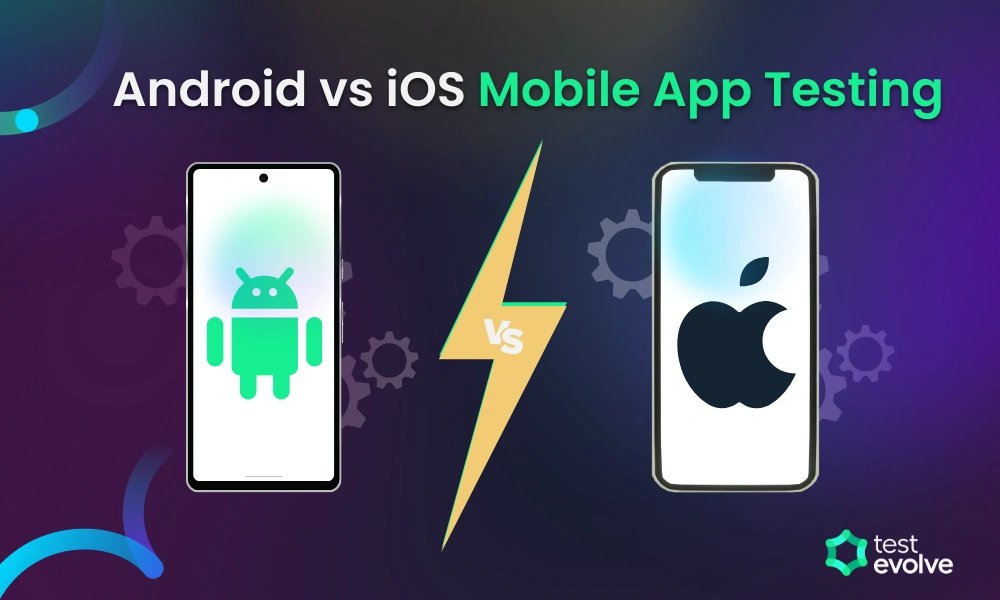Android vs iOS Mobile App Testing
How QA teams can design, prioritise and automate tests for platform-specific success.
Most users of your mobile app won’t remember your code, but they’ll remember where the app froze, where the button didn’t respond, or where the screen broke on their device.
This represents the core challenge of ensuring mobile app quality. It's not just about whether a feature works; it's about whether it works consistently across devices, OS versions, and user environments.
Research shows that 70% of users abandon apps that crash or load slowly. (AppsFlyer)
This is where Android vs iOS mobile app testing moves beyond checkbox thinking. These platforms may support similar features, but they don’t behave the same way. When things go wrong, they don’t fail the same way either. Differences in architecture, UI rendering, test tooling, and how devices handle apps all add up.
In the sections ahead, we’ll break down how testing differs across Android and iOS, so your QA team can design smarter, platform-aware strategies from the ground up. Let’s begin!
Key Takeaways
Android and iOS may look similar to users, but they behave very differently under the hood, and so does the testing.
Android testing means covering more devices and OS versions. iOS testing is about consistency and following Apple’s rules.
Each platform has its own failure patterns, like layout glitches on Android or app rejections on iOS.
Emulators are useful, but only real devices show how apps behave in real-world conditions.
If you’re running the same test scripts on both platforms, it’s time to rethink your approach.
What Makes Android and iOS So Different to Test?
At first glance, iOS and Android may seem like two sides of the same coin, but their ecosystems are fundamentally different from a testing perspective.
Apple controls the entire iOS stack, from hardware to software. That means fewer device models, tighter OS versioning, and a more predictable environment for testers. If you're testing iPhone apps on devices, there's a high chance your test runs will match the real-world user experience.
But with tight control also come strict rules: App Store reviews, provisioning profiles, and signed builds are all part of the process.
Android, on the other hand, is open-source and fragmented by design. Devices from Samsung, Xiaomi, OnePlus, and dozens of others all run slightly different flavours of the OS, some heavily skinned, some months behind in updates.
This diversity makes Android vs iOS mobile app testing less about managing rules and more about managing risk. You’re not just testing features; you’re testing environments.
iOS testing often focuses on compliance and consistency, while Android testing demands coverage and adaptability. Your QA strategy must include that.
Do Design Guidelines Affect Testing Outcomes? Absolutely!
Even when two platforms share the same feature, they often present it very differently. That’s because Android and iOS follow distinct UI/UX design systems, i.e., Material Design vs Human Interface Guidelines, each with its own layout logic, interaction styles, and animation behaviour.
For QA teams doing iOS and Android app testing, this isn’t just a visual difference. It directly affects what needs to be tested and where bugs are likely to appear.
Layout drift is a common, platform-specific challenge.
A component that looks perfect on iOS might break on Android due to constraint differences, padding rules, or text rendering. This is especially noticeable in responsive layouts, dynamic content, or RTL (right-to-left) languages.
Accessibility issues show up differently on each OS
While both platforms support accessibility features, their implementation differs. Label handling, voiceover behaviour, and focus order may pass on iOS but fail silently on Android. Thorough iPhone application testing must include these platform quirks, even when using shared codebases.
By aligning your UI checks with each platform’s design system, you’re not just improving aesthetics; you’re preventing bugs that impact real users.
Related reading: 12 Critical Mobile App Testing Scenarios Every QA Team Should Use
Deployment, Provisioning & App Signing
The way apps are packaged, signed, and delivered isn’t just a dev task; it directly affects how QA teams run, stage, and validate their tests. Here’s how release and deployment impact iOS and Android mobile testing in practice:
| iOS Testing | Android Testing |
|---|---|
| Requires provisioning profiles, signing certificates, and device registration, even for internal builds. | Developers and testers can distribute builds through any channel, enabling quicker feedback cycles. |
| QA teams must front-load validation. App Store rejections delay releases by days or weeks. | Faster submission process shifts quality control to internal QA; there are fewer barriers, but more risk exposure. |
| Limited install options can slow agile testing, especially for external stakeholders or CI pipelines. | Flexible install paths support automation tools, emulator farms, and hybrid pipelines more easily. |
Even with shared test cases, differences in delivery models significantly impact the structure of the QA cycle. Also, for anyone trying to try iOS on Android, it’s worth noting: emulator behaviour, deployment steps, and signing restrictions still follow the platform’s original rules. There’s no real shortcut.
What Makes Android Fragmentation So Hard to Test For?
Let’s say your app works fine on a Pixel device but then crashes on a Samsung midrange phone running an older Android version. Same feature, same code, different results.
Why? Because fragmentation isn’t just about screen sizes. It’s also about
Custom UI layers
Chipset variations
Permission models, and
OS-level behaviours that shift from device to device.
A feature like background location tracking might behave reliably on one brand but get killed off silently on another due to battery optimisations. An animation that runs smoothly on a flagship device may stutter on lower-end models. These inconsistencies are real and frequent.
That’s where test matrices come in.
Instead of testing on every device, QA teams prioritise based on market share, crash analytics, and usage data. They create a cross-section of OS versions, device types, and screen sizes that reflects real-world coverage.
And no, running Android on iOS or trying to simulate it won’t give you reliable answers; hardware and OS-level differences go deeper than emulators can reach. For high-impact coverage, real devices still matter.
To get through this, many teams turn to integrated platforms with iOS and Android testing tools that support both emulators and real devices, at scale and in parallel.
Learn how to apply the platform-specific strategies covered here with practical frameworks and tooling insights
Watch our latest webinar on mobile app test automation for Android.
Get practical frameworks, tooling comparisons, and common Android automation mistakes QA teams often make.

James Readhead
Co Founder, Product Officer and Head of Testing, Test Evolve
Which Automation Framework Should You Use, and When?
Choosing a test framework isn’t just about what works; it’s about what fits. Here’s a quick way to decide between native and cross-platform frameworks depending on your app, team, and testing goals.
→ Need fast, platform-specific UI tests with deep integration?
Go native.
iOS: XCUITest offers speed, stability, and seamless integration with Xcode.
Android: Espresso or UI Automator give you reliable access to native elements.
Use this route when your team has platform specialists or your app relies heavily on native interactions.
→ Need to test across both platforms with shared logic?
Go cross-platform.
Appium is the go-to for flexibility. It’s slower but lets you reuse tests across iOS and Android, ideal for web-to-mobile teams or hybrid stacks.
And no, trying to run Android in iOS to shortcut test coverage won’t work. Real platform differences show up in behaviour, not just appearance. In iOS vs Android app testing, there’s no one-size-fits-all framework. The best choice depends on how your app is built and how your team works.
Can Emulators Replace Real Devices? Not Quite.
In theory, emulators and simulators offer a fast, cost-effective way to validate builds. But in Android and iOS mobile app testing, what works on virtual devices doesn’t always hold up in the real world.
Myth: Emulators can fully replace physical testing.
Reality: They miss real-world conditions like battery drain, push notifications, device-specific animations, and background services. Emulators simulate the software environment but not the hardware-level behaviours. As a result, subtle issues like frame rate drops in animations, notification delivery failures, or background service interruptions, often caused by real-world hardware limitations, are not accurately reproduced.
Myth: You only need real devices when shipping to users.
Reality: Real devices catch early regressions, hardware-dependent bugs, and layout inconsistencies before they affect users or beta testers.
Best practice? Use both:
Start with emulators for fast local feedback.
Validate core flows on real devices across priority OS versions and screen sizes.
Automate critical path tests using cloud device labs.
Also, don’t confuse distribution tools with testing platforms. TestFlight Android app alternatives (like Firebase App Distribution) don’t replace device testing either. They're for sharing builds, not validating behaviour.
For confident releases, your strategy should combine emulators for speed and real devices for accuracy; each plays a different role.
Also Worth Exploring: Best Android Emulators For Chromebook in 2025
What Breaks on iOS vs Android, and Why?
Each platform has its own personality and its own breaking points.
On iOS, UI rejections are common if animations feel sluggish or layouts break Apple’s Human Interface Guidelines. Certificate issues can delay builds, and performance throttling kicks in during background activity. Sandboxing improves security but limits test visibility during integrations, one reason iOS app testing demands extra planning for edge cases.
Android's flexibility creates different challenges. Flaky sensor behaviour, aggressive battery optimisations, and inconsistent OS behaviours across brands often break features that work fine on other devices. Its open-source nature also increases risk; QA must validate permission handling, secure storage, and unintended API access.
In short, the Android and iOS operating systems don't just behave differently; they fail differently. That’s why your QA plan can’t mirror one across the other. Test where each is most likely to fall apart, and catch it before users do.
How Can Cross-Platform Teams Plan Smarter Test Coverage?
Not every test needs to run everywhere. But every platform deserves coverage where it matters most. Here are three smart moves for teams managing tests across Android devices and iOS builds:
Authentication flows or API calls can be tested once. But platform-specific UI elements, gestures, and file permissions? Those need their own cases, especially in iOS mobile application testing, where native behaviours often diverge.
It’s the fastest way to catch layout drift between Android and iOS, even if the functionality stays the same.
Rather than testing on every device, prioritise your test matrix based on crash analytics, market share, and target regions. Then scale using real device clouds (like Firebase Test Lab or BrowserStack) plugged into your CI pipeline. Leading QA teams often prioritise Samsung Galaxy models and iPhones, covering 80% of market usage, based on regional analytics.
The goal isn’t total coverage; it’s risk-focused coverage that reflects how your app is used in the wild.
Smarter Testing Starts with Platform Awareness
Testing mobile apps across platforms isn’t just about writing scripts; it’s about knowing what breaks, why it breaks, and where it breaks. iOS and Android demand distinct approaches, from tooling to test coverage strategies, especially when testing across a wide range of Android devices and OS versions.
If you want a deeper dive into mobile test automation, real device strategies, and common pitfalls in Android iOS application testing, don’t miss our webinar on mobile app test automation for Android.
And if you’re looking to accelerate smarter testing processes, start your 30-day free trial of Test Evolve and see how targeted, risk-based testing accelerates your mobile delivery pipeline.


